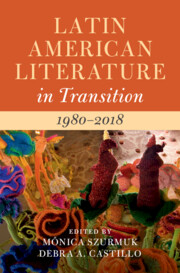Book contents
- Latin American Literature in Transition 1980–2018
- Latin American Literature in Transition
- Latin American Literature in Transition 1980–2018
- Copyright page
- Contents
- Contributors
- Acknowledgments
- Introduction
- Part I Security
- Part II New Genres
- Chapter 5 Speculative Fiction
- Chapter 6 Latin American Digital Literature
- Chapter 7 Children’s Literature in Latin America from School to Marketplace and Beyond
- Chapter 8 Paraliterature
- Chapter 9 Performance Studies
- Chapter 10 Graphing a Hemispheric History of Latinx Comics Creation
- Chapter 11 New Poetry, Fresh Approaches
- Part III Mobilities
- Part IV Positionalities
- Part V Latin American Literature in Global Markets
- Index
- References
Chapter 7 - Children’s Literature in Latin America from School to Marketplace and Beyond
from Part II - New Genres
Published online by Cambridge University Press: 24 November 2022
- Latin American Literature in Transition 1980–2018
- Latin American Literature in Transition
- Latin American Literature in Transition 1980–2018
- Copyright page
- Contents
- Contributors
- Acknowledgments
- Introduction
- Part I Security
- Part II New Genres
- Chapter 5 Speculative Fiction
- Chapter 6 Latin American Digital Literature
- Chapter 7 Children’s Literature in Latin America from School to Marketplace and Beyond
- Chapter 8 Paraliterature
- Chapter 9 Performance Studies
- Chapter 10 Graphing a Hemispheric History of Latinx Comics Creation
- Chapter 11 New Poetry, Fresh Approaches
- Part III Mobilities
- Part IV Positionalities
- Part V Latin American Literature in Global Markets
- Index
- References
Summary
This chapter studies Latin American children’s literature from the 1980s to 2017, written in Mexico, the Southern Cone, the Caribbean, and US Latino countries. It examines a variety of authors from countries such as Mexico, Brazil, and Argentina, among others, as well as US Latino children’s literature and its central themes, such as migration, exile, and bilingualism. It pays attention to the way children’s literature has dealt with ideas about race, gender, and class, questioning ethnic essentialisms and stereotypical gender roles. It analyzes the incorporation of new and alternative family models, and how these works have foregrounded historical and political contexts, as well as the use of orality, regionalisms, and vernacular language, together with the incorporation of humor and an increasing emphasis on the visuality of texts. New technologies have helped establish new relations between different codes, offering new levels of meaning. Children’s and young adult literature has opened up to explore linguistic and cultural diversity through multilingual and intersectional books. Texts discuss and reflect on the role of different ethnic, social, racial, and gender minorities, conveying pacifism and anti-authoritarianism. Around the start of the twenty-first century, texts started to address issues linked to globalization and migrations, crossing the borders between Latin American countries and between Latin America and the United States.
Keywords
- Type
- Chapter
- Information
- Latin American Literature in Transition 1980–2018 , pp. 108 - 122Publisher: Cambridge University PressPrint publication year: 2022



